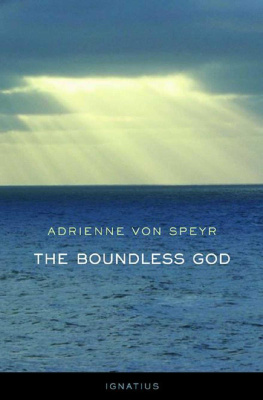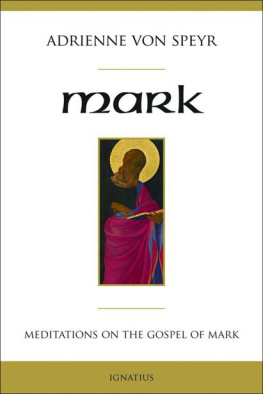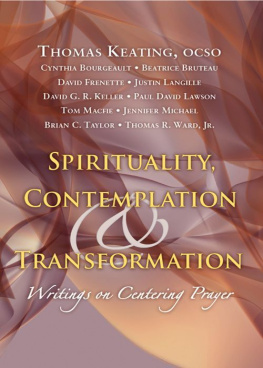LIGHT AND IMAGES
ADRIENNE VON SPEYR
Light and
Images
Elements of
Contemplation
Translated by David Schindler, Jr.
IGNATIUS PRESS SAN FRANCISCO
Original German edition:
Das Licht und die Bilder: Elemente der Kontemplation
1955, Johannes Verlag, Einsiedek, Switzerland
Second edition 1986
Cover art:
The Ascension of Christ
Fra Angelico
Galieria Nazionale dArte Antica, Rome, Italy
Scala / Art Resource, New York
Cover design by Roxanne Mei Lum
2004 by Ignatius Press, San Francisco
All rights reserved
ISBN 978-0-89870-883-7
Library of Congress Control Number 2004103534
Printed in the United States of America
Contents
Gods infinite life and vision is opened to man. Man and world are ontologically ordered to the Son and must be interpreted accordingly. The center of the world: the Cross, wherein Gods entire love, and mans entire disobedience and entire obedience, is revealed. Contemplation must be catholic: both universal and personal. Its community-building function.The loss of a sense for God and for his will because of sin. The Son, as man, re-establishes this sense. The Our Father as inserting the believer into obedience to God. Active love as knowing God and Gods will. The incorporation of those who love into the objective love of the Church and the Son.The grace of faith as the most living life and at the same time as that which comprehends all of lifes movement. Faith as light, which envelopes everything that is illuminated. Light as gift and as appropriated responsibility. Christ as light and as illuminated by faith. Light as the with, as participation. Integration of ones entire everyday life into light.The Yes without shadows; every Yes stems from prayer. The sinners being carried in prayer through others powers of love, so that he can be freed from the shadows of his sin. The shadows that are eliminated, those that remain, and those that are newly formed. The Cross overshadows prayer. Anonymity and the inseparability of the good from the bad shadows. Discrepancy between the fulfilled meaning of the words of prayer and their emptiness and void. Reservations in suffering-with, and their being overcome in love.The night of creation, of sin, and of the Cross: their interpenetration. The Lord distributes his night, but it remains something suffered in him. It is present as a mystery in every faith, and therefore concerns everyone. Analogy between the night of the Cross and Christian existence. The prayer of the day in relation to the night. The prayer of the night made out of the night: out of the Lords night and into the night of the Church and of faith. The necessity of hearing the cry of abandonment. Dying to ones own life in the contemplation of the Cross in order to live on through love.The Church guides ones contemplation; her guidance continues to the threshold at which Gods guidance takes over. In what sense the confessor retains a certain supervision even in the contemplation guided by God. In the night of the obstructed day. Awakening from the night, the repeated awakening that continues to be characterized by the night: at the end of the night, and in a relative sense within the period of night.Reading Scripture and attaching oneself to God in prayer; both of these together make up contemplation. Contemplation as the attempt to gaze upon the incarnate Word: in himself, in his relationship to the world, and in his relationship to the Father. How a person contemplates an esteemed fellow human being. Word and sacrament in mutual fecundation. The Lords counsels as paths to understanding. His presence in law and commandment; in contemplation, Gods Word as commandment and as historical existence in the flesh come together in unity. Christian existence out of the contemplation of the Word, who includes us in his circular journey. Human word as image and basis, the ever-greater of the divine Word. The power of Gods Word in heaven. Contemplation as responding to the Word; inclusion and distance. The unity of being and act in the Son, the unity of contemplation and action in the one contemplating.For us, the world consists of images, and these must be interpreted in view of the Son. The uniqueness of all images of the world; their value for God. Jesus image of the world is open and accessible to the believer. Distance and proximity to things in faith, God-willed joy in the world, but a joy ordered to Christ. The beauty of things, Christian art. The eternal dimension of images, their relationship with Gods Word. Images in the sphere and on the margins of contemplation. Prayer and constant everyday interchange of image and frame.The Son as image of the Father. The concreteness of heaven in revelation. The images of the apocalypse; the same eyes of the visionary see both heaven and earth. Today you will be with me in paradise; I see heaven opened up: the image-transcending presence of heaven. The transference of earthly reality into the kingdom of heaven. Objectivity as the precondition for such a transposition: both in the Incarnation (heaven coming to earth) and for the eschatological promise (earth entering into heaven). Preserving on earth the images of heaven. Contemplation of heaven possible only within the concreteness of revelation. Earthly and heavenly contemplation complement one another. Christ, as the God-man, is the measure for faiths contemplation.The uncloseable gap in the contemplation of the Lords miracle and his essence as God made man. In the parables, there is at first a continuity between the earthly and the divine, but then the chasm appears. The parables are simple and yet contain an inexhaustible mystery. The Sons capacity to create images of the kingdom of heaven and to fill them with eternal life.The world that can be divided up numerically as the revelation of the one God. Man, woman, and child as image. The holy family as a higher image. Jesus human nature as the manifestation of the entire triune life of God, Number and number series as an image. The entire economy of salvation as rooted in the trinitarian God. The Our Father and the images that the Son places in it. Man as image. The Son in his fulness as the recapitulation and unity of the world, as the comprehensive image.
Introduction
There is no end to teaching about prayer, especially contemplative prayer. Adrienne von Speyr has already published an extensive work on the subject, The World of Prayer , in which she descends from the eternal conversation within God himself, passes through the prayer of Christ and Mary, and leads us to the fullness of the states of life and situations within the Church: the prayer of those who are consecrated to God, of those with the office of priesthood, of the married laity who live in the world; the prayer of people at different ages and stages in life.
The present little book complements the more extensive work in a decisive way. Here, the theme is the highest and broadest theological presuppositions of contemplative prayer. The whole is governed, just as it is in Thomas Aquinas, by the reciprocal relationship between light ( lumen ) and image ( species ).
Gods revelation is twofold: on the one hand, the communication of his eternal light of truth, of life, and of love, which becomes visible and manifest to us in Jesus Christ (I am the light of the world) and sinks into our heart as the light of the Holy Spirit ( O lux beatissima ), of faith, of hope and of love, so that the light is both present before us [ gegenstndlich ] and present within us [ in-stndlich ], both objective and subjective. As such, it therefore binds us to and gives us a share in the object of Gods revelation in the most intimate way possible. This light of divine truth and love that pours itself out into the world also appears, however, in the form of the shadows and the night of the Cross, at least insofar as the Cross is the Redeemers atoning and reconciling assumption of human vanity and darkness, a work that places the contemplating believer also under this same law.
Next page
















